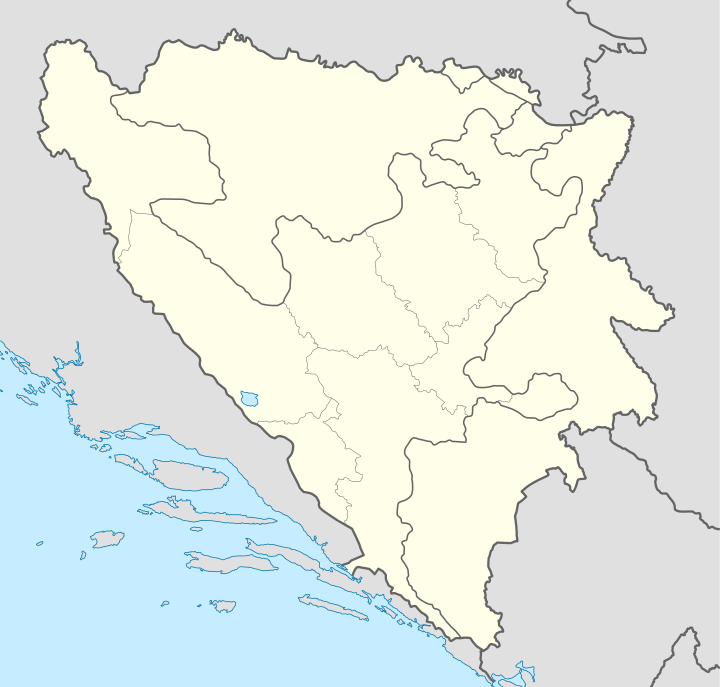Kravica
| Kravica | |
|---|---|
| Village | |
 Kravica | |
| Coordinates: 44°13′N 19°12′E / 44.217°N 19.200°E | |
| Country |
|
| Municipality | Bratunac |
| Population (1991) | |
| • Total | 357 |
Kravica (Cyrillic: Кравица) is a predominantly Serb populated village in the Bratunac municipality near Srebrenica, Bosnia and Herzegovina.
In 1991, it had a population of 357, of whom 353 were declared as Serbs, with no declared Bosniaks, Croats or Yugoslavs. During the 1992-95 Bosnian War, the village was badly damaged in the 1993 attack, and in 1995 was place of a major killings during the Srebrenica massacre.
History
Bosnian War
January 1993 massacre
On 7 January 1993 (Orthodox Christmas Day), the Bosnian forces under Naser Orić attacked the Serb-majority village of Kravica from the demilitarized zone of Srebrenica. Eleven civilians were killed and most of the houses were damaged after the battle.[1]
July 1995 massacre
On 13 July 1995, executions were conducted in the largest of four warehouses (farm sheds) owned by the Agricultural Cooperative in Kravica. Between 1,000 and 1,500 Bosniak males trying to escape Srebrenica had been captured in fields near Sandići and detained in Sandići Meadow. The captives, both civilians and prisoners of war, were brought to Kravica, either by bus or on foot, the distance being approximately one kilometre. A witness recalls seeing around 200 men, stripped to the waist and with their hands in the air, being forced to run in the direction of Kravica. An aerial photograph taken at 14.00 hours that afternoon shows two buses standing in front of the sheds.[2][3]
At around 18.00 hours, when the men were all being held in the warehouse, VRS soldiers threw in hand grenades and opened fire with various weapons, including an anti-tank gun. In the local area it is said that the mass murder in Kravica was unplanned and started quite spontaneously when one of the warehouse doors suddenly swung open. Armed guards shot at the men who tried to climb out the windows to escape the massacre. When the shooting stopped, the shed was full of bodies. There were three survivors of the slaughter in the farm shed.[2][3]
There was more killing in and around Kravica and Sandići. Even before the murders in the warehouse, some 200 or 300 men were formed up in ranks at the point of their capture near Sandići and then mown down with machine guns. At Kravica, it seems that the local population had a hand in the killings. Some victims were mutilated and killed with knives. The bodies were taken to Bratunac or simply dumped in the river that runs alongside the road.[2][3]
Evidence and responsibility
Analysis of hair, blood and explosives residue, collected at the Kravica Warehouse, provide strong evidence of the killings. Experts determined the presence of bullet strikes, explosives residue, bullets and shell cases, as well as human blood, bones and tissue adhering to the walls and floors of the building. Forensic evidence presented by the ICTY Prosecutor link between the executions in Kravica and the primary mass grave known as "Glogova 2", in which the remains of 139 people were found. No blindfolds or restraints were found. In the secondary grave known as "Zeleni Jadar 5", there were 145 bodies, a number of which were charred. Pieces of brick and window frame which were found in the "Glogova 1" grave that was opened later also established a link with Kravica. Here, the remains of 191 victims were found.[2][3]
Precisely which Bosnian Serb units were involved in the Kravica executions cannot be stated with any certainty. There were certainly personnel of the Drina Corps in the area at the time, and the headquarters of one of the Bratunac Brigade battalions was only 400 metres from Glogova. However, there are also indications that a detachment of Military Police could have been involved in burying the victims. One Bosnian Serb witness observed soon after the executions that both VRS and Special Police could well have been involved. Given the proximity of the headquarters, the request for the earthmover, and the fact that military transport was making regular use of the road through Kravica, it is almost inconceivable that the Drina Corps could have been unaware of what was going on in the area.[2][3]
References
- ↑ "The Myth of Bratunac: A Blatant Numbers Game". Research and Documentation Center. Archived from the original on 8 May 2009.
- ↑ 2.0 2.1 2.2 2.3 2.4 "Report of the Secretary-General pursuant to General Assembly resolution 53/35: The fall of Srebrenica" (PDF). United Nations. 15 November 1999.
- ↑ 3.0 3.1 3.2 3.3 3.4 "Prosecutor vs. Radislav Krstić: Judgement" (PDF). International Criminal Tribunal for the former Yugoslavia. 2 August 2001.
External links
- Jelacic, Nerma (2 August 05). "Serbs Subvert Srebrenica Commemoration". Institute for War & Peace Reporting. Check date values in:
|date=(help)